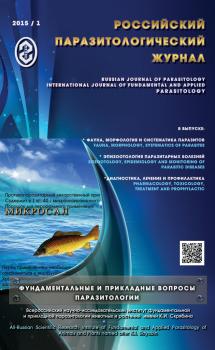The purpose of the study is to develop new effective treatment of demodicosis in dogs with the use of klozantin and immunomodulators. The materials and methods. The work carried out at 45 home dogs of different breeds aged from 5 months up to 2 years, spontaneously infested demodexes, on the basis of a shelter for dogs and private veterinary clinic in Moscow. For the formation of test groups of animals preinfestation of dogs was determined by the study of the skin. This is determined by: a) the index number of ticks; b) clinical signs of each animal. The calculation of the dose of klozantin for each animal was performed taking into account body mass prior to treatment. Closantel, were injected subcutaneously at 0, 7th, 14th, 21st, 28th, 35th, 42nd and 49th days in doses of 2.5; 3.5 and 5.0 mg/kg for closantel in each group, respectively. Efficacy against ectoparasites took into account the results of clinical and laboratory examinations of skin scrapings after 4 and 8 weeks after application (on the 28th and 56th days from start of treatment). After determining therapeutic doses worked 4 patterns of use of the drug with different immunomodulators and without them. As the base drug used tablets, sipli” (production of “Forte Dogde”, USA) at a dose of 3.0 mg/kg in cythioate with multiplicity 2 times a week for 12 consecutive weeks according to the instructions for use. The results and discussion. Closantel the drug at a dose of 5.0 mg/kg for closantel with 12-fold subcutaneous application with multiplicity 1 time per week in combination with the immunomodulatorpolyoxidonium-vet, applied subcutaneously 2 times a week at a dose of 0.15- 0.3 mg/kg (depending on weight of dog) during the first 3 weeks of beginning treatment, showed 100% efficiency in demodicosis dogs. The effectiveness of klozantin at the same dose and frequency in combination with other immunomodulators (ribotan, Roncoleukin) was significantly lower.
demodicosis, dog, closantel, immunomodulators, efficiency.
Введение
Демодекоз собак является распространенным заболеванием, трудно поддающимся лечению, особенно в генерализованной форме. Существующие традиционные схемы лечения, основанные на обработке животных амитразом, макроциклическими лактонами, являются трудоемкими, дорогостоящими и требуют многократных повторений в течение длительного времени. Это часто вызывает побочные эффекты у животных, а около 25% собак не поддаются лечению [2, 6].
Диагноз на демодекоз обычно ставится на основании клинических проявлений и подтверждается наличием клещей на разных стадиях развития в соскобах кожи. Лечение основано на медикаментозной борьбе с клещами и поддерживающей терапии. Поскольку полный жизненный цикл клеща Demodex canis составляет от 18 до 24 дней, а также учитывая сложности при лечении генерализованной формы демодекоза, рекомендуется проводить повторные циклы лечения. Имеющиеся в настоящее время терапевтические средства позволяют проводить повторное лечение ежедневно, еженедельно, раз в 2 недели или ежемесячно в течение 3 месяцев и более [2, 6]. Применение некоторых препаратов может быть трудоемким, дорогостоящим, не всегда эффективным и вызывать побочные эффекты.
1. Arhipov I.A. Antigel’mintiki: farmakologija i primenenie. - M., 2009. - 509 s.
2. Vasilevich F.I., Larionov S.V., Burmistrova M.I. Demodekoz: monografija. - M.: ZooVetKniga, 2015. - 272 p.
3. Mamykova O.I. Metodicheskie polozhenija po primeneniju immunomodelirujushhih sredstv v kombinirovannoj terapii gel’mintozov // Rossijskij parazitologicheskij zhurnal. - 2015, № 2. - pp. 120-123.
4. Shipstoun M. Generalizovannyj demodekoz u sobak, klinicheskie perspektivy // Rossijskij veterinarnyj zhurnal. Melkie domashnie i dikie zhivotnye. - 2008, № 1. - pp. 33-35.
5. Jastreb V.B. K voprosu o juvenil’nom demodekoze sobak // Mater. dokl. nauch. konf. «Teorija i praktika bor’by s parazitarnymi zabolevanijami». - 2015, vyp. 16. - S. 506-509.
6. Mueller R.S., Bensignort E., Ferrer L. et al. Treatments of demodecosis in dogs: 2011 clinical practice guidelines //Veterinary Dermatology. - 2012. - V. 23, N 2. - P. 86 - 96, pp. 20-21.





